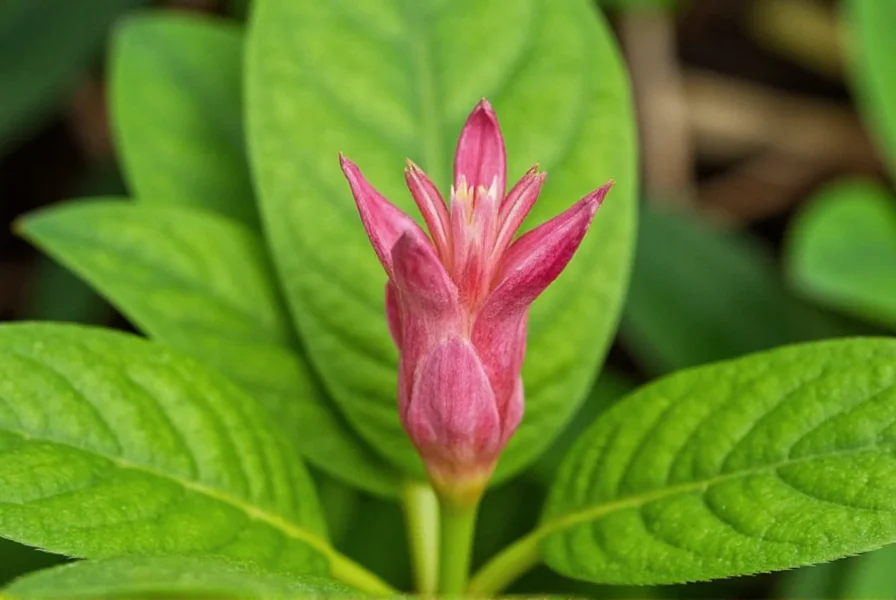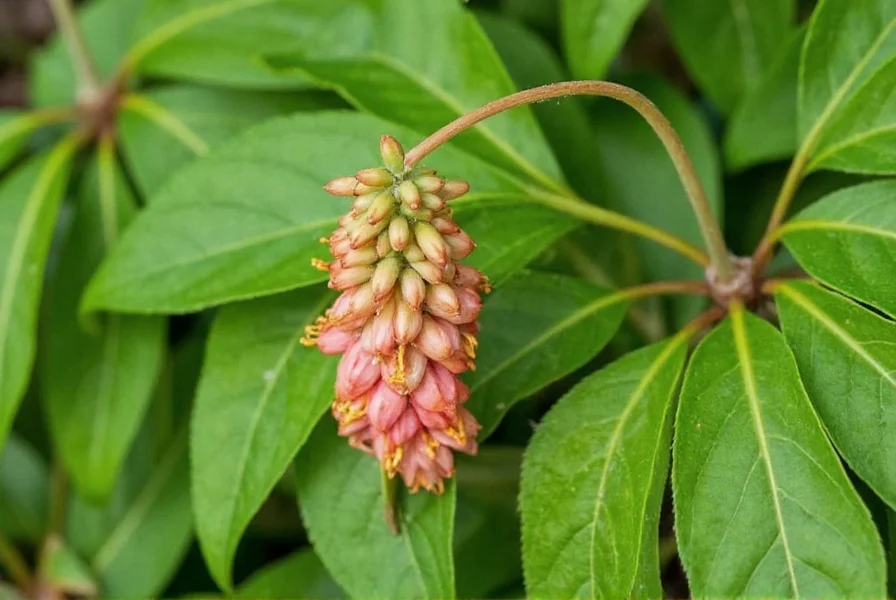Often called white ginger lily or garland lily, butterfly ginger belongs to the Zingiberaceae family but differs significantly from culinary ginger (Zingiber officinale). While both share rhizomatous growth habits, butterfly ginger's primary value lies in its ornamental beauty rather than culinary use. This distinction makes understanding butterfly ginger characteristics essential for gardeners seeking to enhance their tropical landscapes with this stunning plant.
Botanical Profile and Identification
Butterfly ginger's scientific name, Hedychium coronarium, reflects its crown-like flower arrangement ("coronarium" meaning crown). The plant produces pseudostems formed by tightly wrapped leaf sheaths, creating a bamboo-like appearance. Each stem typically bears 1-2 flower spikes that emerge from the leaf axils.
The distinctive flowers feature:
- Three white petal-like structures (tepals)
- A prominent orange-yellow labellum (modified petal)
- Delicate stamens forming a protective hood over the pistil
- Intense evening fragrance attracting nocturnal pollinators
| Feature | Butterfly Ginger | Common Ginger |
|---|---|---|
| Scientific Name | Hedychium coronarium | Zingiber officinale |
| Primary Use | Ornamental | Culinary/Medicinal |
| Flower Color | White with orange center | Yellow-green |
| Fragrance | Strong, sweet, jasmine-like | Mild, spicy |
| Rhizome Edibility | Not typically consumed | Commonly used |
Growing Requirements for Optimal Performance
Successful cultivation of butterfly ginger depends on replicating its natural tropical habitat. Gardeners seeking how to grow butterfly ginger in tropical climates should prioritize these conditions:
Climate considerations: This plant thrives in warm, humid environments with temperatures between 70-90°F (21-32°C). While it can survive brief dips to 25°F (-4°C), prolonged cold damages the rhizomes. In USDA zones 8-10, mulch heavily before first frost to protect rhizomes through winter.
Soil preferences: Well-draining, organically rich soil with slightly acidic to neutral pH (6.0-7.0) provides ideal growing conditions. Amending garden soil with compost improves both drainage and nutrient content. Avoid heavy clay soils that retain excessive moisture.
Light requirements: Butterfly ginger performs best with morning sun and afternoon shade in hot climates. In cooler regions within its hardiness zone, it can tolerate full sun. Insufficient light results in leggy growth and reduced flowering.
Planting and Maintenance Guide
For those implementing a butterfly ginger rhizome planting guide, follow these steps for successful establishment:
- Plant rhizomes in spring after last frost, 2-4 inches deep with growth buds facing upward
- Space plants 2-3 feet apart to allow for mature spread
- Water thoroughly after planting, maintaining consistent moisture without saturation
- Apply balanced fertilizer monthly during active growing season
- Remove spent flower spikes to encourage additional blooming
Regular maintenance includes monitoring for common issues like spider mites in dry conditions and fungal diseases during prolonged wet periods. The plant's natural pest resistance makes it relatively low-maintenance compared to other tropicals. When implementing butterfly ginger plant care tips, remember that established plants tolerate occasional drought but produce their best displays with consistent moisture.
Propagation Techniques
Dividing rhizomes remains the most reliable propagation method for butterfly ginger. The optimal time for division coincides with new spring growth. Carefully dig up established clumps and separate rhizomes, ensuring each division contains at least one growing bud. Replant divisions immediately at the same depth they previously grew.
While seed propagation is possible, it proves less reliable and significantly slower than rhizome division. Seeds require warm temperatures and consistent moisture to germinate, often taking several weeks to sprout. For gardeners seeking managing butterfly ginger in home landscapes, division provides the quickest route to expanding plantings.
Traditional Uses and Modern Applications
Cultures throughout Asia have incorporated butterfly ginger into traditional practices for centuries. In Ayurvedic medicine, practitioners have used the rhizomes for various purposes, though modern research on butterfly ginger medicinal uses traditional applications remains limited. The fragrant flowers often feature in ceremonial garlands across Southeast Asia.
Contemporary gardeners primarily value this plant for its ornamental qualities. The intense evening fragrance makes it ideal for placement near patios or walkways. Landscape designers frequently incorporate it into tropical gardens, water features, and as a dramatic backdrop for lower-growing plants. Its ability to form dense clumps also makes it effective for erosion control along waterways.

Seasonal Care Considerations
Gardeners in temperate zones face unique challenges with butterfly ginger winter care in temperate zones. As temperatures drop below 50°F (10°C), the plant naturally begins dormancy. Before first frost, cut back foliage to 6 inches above soil level and apply 4-6 inches of mulch. In containers, move plants to an unheated garage or basement maintaining temperatures above freezing.
During active growing season, monitor for these common issues:
- Yellowing leaves: Often indicates overwatering or poor drainage
- Fewer blooms: Typically results from insufficient light or nutrients
- Leaf spot: Usually fungal, treat with copper-based fungicide
- Stunted growth: May signal need for division or nutrient deficiency
Designing with Butterfly Ginger
When incorporating this dramatic plant into landscape designs, consider these strategies for maximum visual impact:
- Plant in groups of three or more for bold tropical statement
- Position against dark green backdrop to highlight white flowers
- Combine with complementary plants like canna lilies and elephant ears
- Use as focal point in moon gardens for evening fragrance enjoyment
- Place near water features where its natural habitat preferences are met
Understanding best conditions for butterfly ginger blooms ensures spectacular floral displays. The plant typically flowers from late summer through fall, with peak blooming occurring when day length decreases. Providing consistent moisture during bud formation significantly increases flower production.
Frequently Asked Questions
Is butterfly ginger edible?
No, butterfly ginger (Hedychium coronarium) is not considered edible. While related to culinary ginger (Zingiber officinale), its rhizomes contain different compounds and are primarily grown for ornamental purposes. Consuming butterfly ginger may cause digestive discomfort.
How fast does butterfly ginger spread?
Butterfly ginger spreads moderately fast through underground rhizomes, typically expanding 12-24 inches per year under ideal conditions. In optimal tropical environments, it can form dense colonies over several seasons. Gardeners should provide adequate space or install root barriers to manage its spread.
Why isn't my butterfly ginger flowering?
Lack of flowering typically results from insufficient light, inadequate nutrients, or improper watering. Butterfly ginger requires partial sun (morning sun with afternoon shade in hot climates), consistent moisture during growing season, and regular feeding with balanced fertilizer. Plants need at least two years to mature before producing significant blooms.
Can butterfly ginger grow in containers?
Yes, butterfly ginger grows well in containers when provided with proper care. Use a large pot (at least 18 inches diameter) with excellent drainage. Container-grown plants require more frequent watering and feeding than in-ground specimens. During winter in cooler climates, containers can be moved indoors to protect the plant from freezing temperatures.
How do I identify butterfly ginger versus other ginger varieties?
Identify butterfly ginger by its distinctive white flowers with orange centers that resemble butterflies, intense evening fragrance, and tall growth habit (6-8 feet). The leaves grow in two ranks along the stem, creating a flattened appearance. Unlike culinary ginger, butterfly ginger produces showy flowers and has a more upright growth habit with less branching.











 浙公网安备
33010002000092号
浙公网安备
33010002000092号 浙B2-20120091-4
浙B2-20120091-4